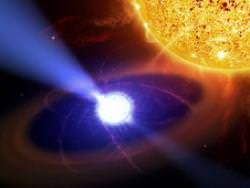A group of astronomers have discovered something they never expected to find. The scientists were studying white dwarf stars, hoping to learn if white dwarfs could be responsible for the cosmic rays that zip through our galaxy and occasionally strike earth. But instead, what they found was that a certain white dwarf star known as AE Aquarii acts like a Pulsar, challenging our understanding of white dwarfs.
Astronomers had believed white dwarfs were inert stellar corpses that slowly cool and fade away, but this recently observed white dwarf star emits pulses of high-energy X-rays as it whirls around on its axis.
A group of astronomers from the US and Japan used the Suzaku X-Ray Observatory, a JAXA and NASA telescope in Earth orbit to make the new observations.
“AE Aquarii seems to be a white dwarf equivalent of a pulsar,” says Yukikatsu Terada, from the Institute of Physical and Chemical Research in Wako, Japan. “Since pulsars are known to be sources of cosmic rays, this means that white dwarfs should be quiet but numerous particle accelerators, contributing many of the low-energy cosmic rays in our galaxy.”
Some white dwarfs, including AE Aquarii, spin very rapidly and have magnetic fields millions of times stronger than Earth’s. These characteristics give them the energy to generate cosmic rays. But the Suzaku observatory also detected sharp pulses of hard X-rays. After analyzing the data, the astronomy team realized that the hard X-ray pulses match the white dwarf’s spin period of once every 33 seconds.
The hard X-ray pulsations are very similar to those of the pulsar in the center of the Crab Nebula. In both objects, the pulses appear like a lighthouse beam, and a rotating magnetic field is thought to be controlling the beam. Astronomers think that the extremely powerful magnetic fields are trapping charged particles and then flinging them outward at near-light speed. When the particles interact with the magnetic field, they radiate X-rays.
“We’re seeing behavior like the pulsar in the Crab Nebula, but we’re seeing it in a white dwarf,” says Koji Mukai of NASA Goddard Space Flight Center in Greenbelt, Md. The Crab Nebula is the shattered remnant of a massive star that ended its life in a supernova explosion. “This is the first time such pulsar-like behavior has ever been observed in a white dwarf.”
Original News Source: NASA/Goddard Spaceflight Center Press Release


Another example of the continuum between discrete categories. Left to Right. North to South, East to West.
We await some more exciting puzzles.
How now? You mean the textbook white dwarf model could be seriously flawed? Out brief [standard] candle.